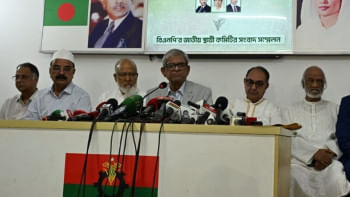Moving lower middle income status forward
The news is refreshing, particularly since Bangladesh is always on the spotlight for its negative image. Moving to the World Bank's 'lower middle income' category through achieving higher Gross National Income is an addition towards improving the impression of the country. It has now joined an upgraded league where 51 out of 215 countries of the world are placed. This graduation of Bangladesh is an indication that despite various bottlenecks such as political turmoil, poor governance and natural disasters, the country is resilient and has been able to exhibit higher and steady economic growth over the years.
Enhanced image can bring in positives in the form of higher opportunities for commercial loans from the global market and higher foreign investment. But it also means getting soft loans from development agencies may become tougher. The rate of interest may be higher and the repayment period shorter than what is offered to low income countries. To face such situations the country has to be prepared by way of achieving further growth and higher income so that it can generate enough resources for its development to be less dependent on external finance as well as for repayment of any foreign loans.
Further growth will of course hinge on two critical issues: increased investment and building institutions. During the last decade or so, investment growth has not only been modest, but this growth was driven by public sector investment in terms of the larger size of the ADP. However, to achieve a growth of 8 percent, domestic investment has to be increased to 34.4 percent of GDP by FY2020. Investment in infrastructure such as transport and energy sectors will attract investment in other sectors and play a pivotal role in achieving higher growth. The major source of investment, of course, has to be the private sector—both domestic and foreign for which a favourable environment is a
prerequisite. Predicaments such as delay and lack of transparency in the decision making process and lack of effective implementation of regulatory policies act as disincentives, particularly for foreign investment. Good governance and institutional reforms are, therefore, crucial for promoting investment and growth.
Along with investment in infrastructure, we will also need investment in human resource development, skills upgradation, innovation and R&D. We have been too complacent with our achievement in education and health sectors. But the quality of education and health services still remains poor and is not up to mark for an emerging economy. It is time that we act on improving the quality of our human resources through higher allocation of resources and establishing stringent quality control measures. Sadly, our education system does not encourage creativity and science and technology. The number of science graduates is declining relative to business graduates, not only due to students' lack of interest, but also due to the uncertainty of getting suitable jobs. On the other hand, though the economy has been performing relatively well, productivity is very low in all sectors due to lack of skills. Even with good agricultural output, our yield per acreage is lower than countries such as India and Thailand. Same goes for the readymade garments sector where output per worker is lower than other competing countries such as China and Vietnam. Higher productivity cannot be achieved without sophisticated technology.
One has to be mindful of the fact that many countries which are advanced today took several years to graduate from being a lower middle income country (LMIC) to upper middle income country (UMIC). For example, it took 17 years for China, 19 years for South Korea, 27 years for Malaysia and 28 years for Thailand to move from LMIC to UMIC. Also some of our compatriots continue to be in the LMIC despite good economic performances. India has been in the LMIC category since 2007 while Vietnam has been in the same league since 2009. In fact, as countries move to a higher ladder of development, it becomes tougher to continue with the same momentum of growth. That is why growth rates are found to be higher in low income countries than middle and high income countries. A World Bank study shows that since 1960 only 13 out of 101 countries came out of the middle income category and graduated to the high income group in 2008. This is something to be cautious about for aspiring countries.
For Bangladesh, moving ahead also means that it has to diversify its exports and move towards high value products. As the country progresses further, the competitive advantage of cheaper output will fade away. The only way to remain competitive is to manufacture technology supported high value products.
Moving forward into the UMIC category will also mean that income inequality has to be reduced. Without making growth broad based and inclusive, sustainability of growth cannot be ensured. This has to be pursued through the creation of livelihood opportunities for all. But any job is not enough. Jobs have to be in the formal sector that will guarantee wages for a decent living. Social protection for the less privileged sections has to be strengthened as well.
The bucket list is thus quite long for us to move forward. Getting there will depend on how we address the challenges that lie ahead.
The writer is Research Director at CPD, currently a Visiting Scholar at the Earth Institute, Columbia University, New York.

 For all latest news, follow The Daily Star's Google News channel.
For all latest news, follow The Daily Star's Google News channel. 



Comments